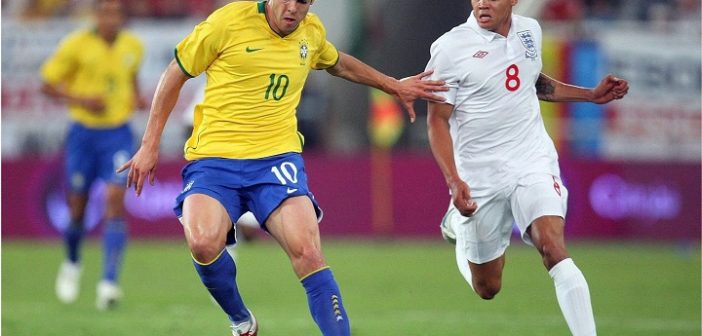Brazilians, with their five World Cups, believe it’s them. But the English, historically, lay claim to be. It’s a good debate!
Brazilians, regardless of sex, are born with a footballing chromosome; it’s in their DNA. Yes, almost every person born in Brazil considers themselves an expert on footballing matters, and self-proclaimed champions of the sport. Well, we are, pretty much, born with a ball at our feet. Every Brazilian knows best how to manage his team, the most effective line-up for each game, argues with the commentators, swears at the coaching staff, and barks orders – quite literally through the TV – at the players during matches, often almost whacking the poor, impartial TV screen. If the team wins on a Sunday, wearing the team strip on the way to work is a Monday morning must, an expression of unbridled pride. My friend, we are a nation of more than 200 million football coaches. And yes: it was, I will admit, necessary to go back a little in history to try and make sense of this modern-day phenomenon.
Let’s go back in time, and uncover a few known facts about how a British sport, the most loved across all continents, arrived in Brazil (thanks, Charles Miller!).
The earliest records of anything vaguely resembling football were discovered in ancient China, around 3000 BC. After victorious battles, the Chinese military used to form teams and kick around decapitated heads of fallen enemy soldiers (how awful!). Olmecs, Aztecs and Mayans also fell in love with the sport: a dozen rubber balls, with diameters of between 10-20cm, were recovered from an ancient sacrificial Olmec site, in El Manatí. The earliest balls date from around 1600 BC. For these people, the game was also linked to religious rituals and sacrifices. In ancient Japan, a game called Kemari was played by members of the Emperor’s court, and the ball was made of bamboo fibre (much better than human heads, don’t you think?). In Greece, around the first century BC, soldiers played Episkiros: there were two teams of nine players on each side, spread around a rectangular pitch. The ball was made of an ox bladder filled with sand or earth.
Hernán Cortés, after the Spanish conquered the Aztecs in 1521, took a team of players to Spain to perform at court. Just imagine the face of the aristocrats, mesmerized by the bouncing balls and these exotic newcomers chasing after it? In Medieval Italy, a game called gioco del calcio was played in the town squares: two teams of 27 players had to guide the ball to the posts, placed at the two extreme corners of the pitch. Can you imagine the chaos with that amount of people? They say that when gioco del calcio arrived in England and evidence suggests that the first British versions had very few rules. Despite quickly becoming popular, it stood out for its extreme violence. For this reason, along with endless petitions signed by local businessmen complaining about the damage caused by playing in the streets, the game was banned by King Edward II on April 13th, 1314, under penalty of imprisonment. He deemed it a non-Christian sport. Didn’t seem to resolve much, did it?
Then, in 1848 in Cambridge, a unique set of rules was established to help define the sport we know today. In 1871 the role of the goalkeeper was introduced; in 1875 the 90 minute match became the standard, and in 1891 the “penalty” appeared for the first time (it seems this was introduced to give rise to the eternal discussion of whether it was or indeed was not a penalty. The unspoken rule is that if the penalty was in favour of your team it’s valid and fair, however, if it was against your team, the referee is a cheat!). The other rule that still generates much discussion is the offside rule, established in 1907. Even with modern day technology, cameras that show every angle and replay in super slow motion, the arguments remain the same. Ah, but if there were no room for debate, where would be the fun?
In Brazil, on May 13th, 1888, curiously the date as the signing of the Lei Áurea (Golden Law) which enforced the abolishment of slavery in Brazil, São Paulo Athletic Club (SPAC) was founded, the oldest sporting club in the city of São Paulo. A group of engineers from the British Railway Company came up with the idea of forming a club to allow them to play their beloved sport, cricket, and enjoy their time off with their families. Among them was Peter Miller (father to Charles Miller). And so SPAC was born. In 1888 the Football League was also founded to organize tournaments and international competitions.
Peter Miller sent his son, Charles Miller (here he is!), to study in England at the age of nine years old. On his return to Brazil in 1894 Charles brought with him in his bag his first football and a set of official rules. All set! Just ask if wasn’t a success!
The first game was held on April 15th, 1895, between the employees of two English companies that had operations in São Paulo; Companhia de Gás (Gas Company) vs. Ferroviária São Paulo (São Paulo Railway Company). In the beginning football was played almost exclusively by the Brazilian elite and it wasn’t until 1934 that the first athlete of African descent, Leonidas Silva, was selected to play in a World Cup
The Fédération Internationale de Football Association (FIFA) was founded in 1904 and, since 1930, has been responsible for the organization of the FIFA World Cup, along with other club competitions such as the FIFA Club World Cup.
But where did this Brazilian passion come from? How can it be that football is almost a religion in these tropical lands? Some say it was the 1950 World Cup; others attribute this love, bordering on fanaticism, to the economic development of the country on those days. There are also those who swear that it is the result of our miscegenation that gifts us our domination of the ball… Certainly, the fact that the “Seleção Canarinho” (translated as Canary Team, being the predominant colour of the official strip) have won five world titles (1958, 1962, 1970, 1994 and 2002) helps a great deal!
And how can you fail to be captivated by such artists like Pelé, Garrincha, Rivelino, Sócrates, Zico, Romário, Ronaldo, Ronaldinho, Rivaldo, Roberto Carlos, Neymar, Kaká, Robinho, Daniel Alves, Luís Fabiano, Nilton Santos, Falcão, Taffarel, Roberto Dinamite…? The list is impressive!
And like passions unexplained, our pulses will continue to race on Sundays inside the Maracanã – the most famous of international stadiums – at the tables of bars that host heated footballing debates, on the 40C sands of the beaches from North to South of this giant country. The roar goes on, full of passion, as the ball bursts the back of the net.
_______________________________________________________________________________________________________________
Read more about Bossa Brazil Magazine (your Brazilian Magazine in London) and Bossa Latinos (Latin America culture in London) at BBMag www.bbmag.co.uk, the only London-based trilingual publication specialised in international lifestyle, travel and tourism, culture, arts, gastronomy, food and drinks.
You can also find Brazilian and Latin American service suppliers in London, and internationally, by visiting BBMAG Business Directory www.bbmag.co.uk/directory.
For more information about Brazil, travelling to Brazil, Holidays in Brazil and Brazilian tourism please also visit VBRATA Visit Brazil Travel Association www.vbrata.org.
















